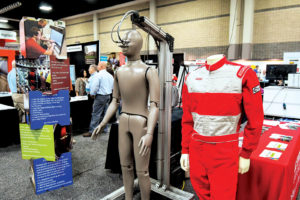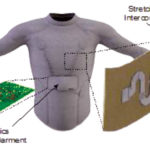Today’s textile testing is challenged with evaluating varied performance qualities for multiple environments.

The Advanced Textiles Testing Track at IFAI Expo examined textile testing in light of a new wave of textile developments. Dr. Emiel Den Hartog, North Carolina State University (NCSU) Center for Research on Textile Protection & Comfort (TPACC), focused on a “multi-level” approach to assessing comfort, ergonomics and functionality in protective clothing.
While testing in the lab is likely to be more accurate, testing in the field has more relevance, according to Den Hartog. “We need to define the optimum balance between protective performance, clothing comfort and physiological strain,” he noted.
Dr. Jesse Jur of NCSU’s Dept. of Textile Engineering, Chemistry and Science outlined the process his group developed to test electronic textiles using conductive inks printed onto TPU film for use on knitted shirts. Jur explained that the category of wearables will require a raft of new testing standards, including the impact of wearing electronics on the body.
Dave Klein of Thomsen Research Associates spoke about the many antimicrobial options and test methods on the market, pointing out
that today’s newer “greener” formulations may require different
types of testing.
Performance testing for the many functions of activewear, from
water repellency and breathability to UV protection and thermal regulation, was discussed by Seemanta Mitra, senior director of global softlines for Intertek.
Dr. Jan Beringer of the Hohenstein Institute summed up the challenges of testing today’s innovative textiles by advising development and testing teams to “get creative, but stay scientific.” Projects such as comparing the performance of faux fur to real fur, or testing the noise level of outdoor fabrics worn in stealth situations, required “looking at the whole picture” to develop appropriate test methods.
The day-long testing track fulfilled a portion of the requirements needed to earn a testing certificate as credit toward the NCSU Textile Technology Certificate Program.
Details count
The comprehensive tutorial on textile testing delivered by Dr. Jan Pegram Ballard of NCSU’s College of Textiles was a useful refresher course for anyone in the business. By highlighting the “little things” that can affect test results, the three-hour class exposed many of the difficulties the textile industry experiences in testing fiber, yarn and fabrics for performance, comfort
and aesthetics.
Standardization in textile testing requires proper calibration of equipment, conditioning of specimens, uniformity in procedures and an agreement on nomenclature, explained Ballard. Yet many tests rely on painstaking preparation of specimens and subjective evaluation by lab technicians, introducing the possibility of human error.
“A test method is useful if it gives reproducible results, which correlate with the parameters of interest to the user,” said Dr. Ballard. “The expense of testing is not at all costly when compared to the cost of returned merchandise and dissatisfied customers.”
Navigating the EPA regulation “Swamp”
Paul Matthai, U.S. Environmental Protection Agency (EPA), says his agency’s regulations are complicated and often don’t “harmonize” with each other. Despite these complexities, Matthai says the U.S. Congress strives to write environmental laws that do not hurt the economy or hinder business.
Nevertheless, Matthai’s presentation, “Navigating the EPA Regulation Swamp,” suggests the process can be daunting. He covered some key regulations, including: Greenhouse Gas Reporting Rule (GHG), Clean Water Act, Safe Drinking Water Act, Resource Conservation and Recovery Act (RCRA), Emergency Planning and Community Right-to-know Act (EPCRA), Toxic Substances Control Act (TSCA) and Federal Insecticide, Fungicide and Rodenticide Act (FIFRA).
Regarding RCRA, Matthai explains that when textile companies generate hazardous waste, it must be managed according to regulations for a specific type. The waste generators are divided into three categories, according to how much waste is generated in a month.
Approximately 85,000 chemicals are listed on the TSCA list, and identified as high or low priority for EPA review. Matthai says that many “trade secret” chemicals are on the list, and more emphasis has been put on chemicals that may affect vulnerable populations like children and pregnant women.
In working with the dyes used by textile manufacturers, he says the EPA tries to give the industry enough time to find safer substitute chemicals, and provide ideas on reducing their waste or using safer manufacturing processes.
Supporting U.S. manufacturing
Jeffrey D. Gerrish, partner in the Skadden, Arps, Slate, Meagher & Flom LLP law firm, based in Washington D.C., presented “Overview of U.S. International Trade Laws,” focusing on laws that support U.S. companies’ efforts to improve their business internationally.
Gerrish said the U.S. has a “massive trade deficit” in manufactured goods ($622 billion in 2015). “Our share of world manufacturing has plummeted,” he said. “We have lost 5 million manufacturing jobs in the last 15 years.” Our biggest trade deficit is with China ($367 billion), which he called “really unsustainable.”
What can be done? He explained our primary trade laws, which are: Antidumping Law (AD); Countervailing Duty Law (CVD); Section 201 of the Trade Act (Global Safeguard); and Section 301 of the Trade Act / WTO Litigation. When asked about the benefits of U.S. trade laws, he said, “These laws are not designed to restrict trade; they’re designed to promote fair trade and correct illegal trade activity.”
Recent changes to the AD/CVD laws were meant to clarify the law and make it closer to its original intent, he said. Congress made it clear to the International Trade Commission (ITC) that changes were meant to provide relief even when there was not a catastrophic occurrence. “Relief cannot be denied because the company is profitable, or because their performance has improved,” he said. “You don’t have to show losses, you don’t need ‘blood on the floor.’”
Student Design Challenge award winners
 Advanced Textile Products (ATP) and the Narrow Fabrics Institute (NFI), divisions of IFAI, announced the winners of the 2016 Advanced Textile Student Design Challenge at the Advanced Textile Reception following Tuesday’s conference at IFAI Expo.
Advanced Textile Products (ATP) and the Narrow Fabrics Institute (NFI), divisions of IFAI, announced the winners of the 2016 Advanced Textile Student Design Challenge at the Advanced Textile Reception following Tuesday’s conference at IFAI Expo.
University of Mass.–Lowell students Linda Pratto, Christian Bain, Patrick Anderso n, William Hallissey and Dana Pierce were the first-place winners for their project “WindHawk,” a wind energy system that supplements the use of diesel generators in austere environments. The team received a prize package worth more than $6,000, which included a trip to IFAI Expo 2016 to present their project to the industry.
n, William Hallissey and Dana Pierce were the first-place winners for their project “WindHawk,” a wind energy system that supplements the use of diesel generators in austere environments. The team received a prize package worth more than $6,000, which included a trip to IFAI Expo 2016 to present their project to the industry.
 Second place went to North Carolina State University (NCSU) student Raj Bhakta for his project “Low-cost, Low-power, Multimodal Biometric Sensing Garment.” Third place went to Julia Duvall and Nicholas Schleif from the University of Minnesota for their project, “Shape Memory Alloy Hug Vest.”
Second place went to North Carolina State University (NCSU) student Raj Bhakta for his project “Low-cost, Low-power, Multimodal Biometric Sensing Garment.” Third place went to Julia Duvall and Nicholas Schleif from the University of Minnesota for their project, “Shape Memory Alloy Hug Vest.”
This year’s challenge was to use textiles as a major component to design aerospace, medical, military, safety/protective or other wearable and nonwearable textile technology applications.
 TEXTILES.ORG
TEXTILES.ORG


